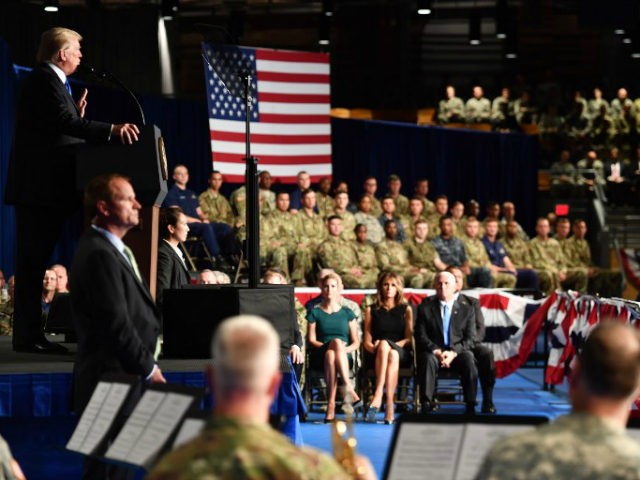Additional U.S. service members are expected to start deploying to Afghanistan within days to weeks as part of President Donald Trump’s newly unveiled strategy to ultimately end the conflict and eradicate the jihadi threat stemming from the country.
Trump defined what he described as an attainable U.S. victory in the 16-year-old war as “obliterating ISIS [Islamic State], crushing al-Qaida, preventing the Taliban from taking over Afghanistan and stopping mass terror attacks against America before they emerge.”
Citing anonymous senior officials, the Associated Press (AP) reports that Trump’s Afghan war plan involves deploying up to 3,900 U.S. troops.
Gen. Joseph Votel, the chief of U.S. Central Command (CENTCOM), charged with military activity in the Middle East and Afghanistan, indicated that he expects the first deployment to arrive “pretty quickly,” within days or weeks.
“What’s most important for us now is to get some capabilities in to have an impact on the current fighting season,” Gen. Votel told reporters, according to AP.
“Most of the new forces will train and advise Afghan forces to improve their combat abilities, or provide security for American adviser teams in the field,” indicated the CENTCOM commander.
Although the U.S. Department of Defense (DOD) plans are reportedly based on 3,900 additional troops, the particular number will vary as conditions change, senior U.S. officials told ABC News on condition of anonymity.
ABC News learned from the unnamed U.S. officials that Defense Secretary James Mattis has not yet signed any orders to send more troops to Afghanistan.
Deploying additional troops is expected to take time, the anonymous U.S. officials told ABC News.
There were 8,300 American troops in Afghanistan as of mid-May, according to a U.S. watchdog agency.
In a national address Monday, President Trump vowed to achieve victory, saying that his administration will “seek an honorable and enduring outcome worthy of the tremendous sacrifices that have been made, especially the sacrifices of lives.”
“The men and women who serve our nation in combat deserve a plan for victory,” he added. “They deserve the tools they need, and the trust they have earned, to fight and to win.”
Trump refused to provide a specific number for the number of troops that the U.S. will deploy, saying he did not want to broadcast his plans to the enemy as has been done in the past, resulting in devastating consequences.
Since the war started in October 2001, terrorists, primarily the Taliban, have killed 2,257 U.S. service members and injured 20,257 others. The U.S. has also invested an estimated $714 billion, both on security and reconstruction efforts, throughout the conflict.
Trump’s plan is expected to extend the American military presence in Afghanistan, empower his generals and troops by lifting restrictions on rules of engagement, and pressure neighboring Pakistan not to sponsor terrorism.
While many critics have dismissed the plan as an extension of the status quo, Trump’s strategy includes at least a couple of significant components that set it apart from the failed policies of his predecessors: one is lifting the restrictions imposed by his predecessor that prevented the U.S. military from effectively combating the enemy, and two is placing pressure on Pakistan to stop supporting jihadists who are fighting and killing Americans in Afghanistan.
Trump inherited chaotic security conditions in Afghanistan that have been deteriorating since former President Barack Obama declared the U.S. combat mission complete at the end of 2014, reducing the number of American troops in the country to about 10,000.
“When I became president, I was given a bad and very complex hand, but I fully knew what I was getting into: big and intricate problems,” the president declared. “But, one way or another, these problems will be solved — I’m a problem solver — and, in the end, we will win.”
Under Obama, the U.S. military “lost its authority” to offensively target the Taliban, prompting some American troops to complain that they were unsure about when it was acceptable to shoot the terrorists.
The Obama-era ban on offensively targeting the Taliban required U.S. troops to wait for the Taliban to shoot at them first before they could retaliate.
While the Pentagon did not immediately respond to Breitbart News’s request for comment on whether the Trump administration has snapped back the authority to go after the Taliban, the U.S. commander-in-chief vowed Monday:
We will also expand authority for American armed forces to target the terrorist and criminal networks that sow violence and chaos throughout Afghanistan. These killers need to know they have nowhere to hide; that no place is beyond the reach of American might and Americans arms. Retribution will be fast and powerful.
President Trump suggested that he will change the rules of engagement to liberate U.S. troops from restrictions.
“My administration will ensure that you, the brave defenders of the American people, will have the necessary tools and rules of engagement to make this strategy work, and work effectively and work quickly,” he proclaimed.
“I have already lifted restrictions the previous administration placed on our warfighters that prevented the secretary of defense and our commanders in the field from fully and swiftly waging battle against the enemy,” he added. “They are won in the field, drawing upon the judgment and expertise of wartime commanders and frontline soldiers acting in real time, with real authority, and with a clear mission to defeat the enemy.”

COMMENTS
Please let us know if you're having issues with commenting.